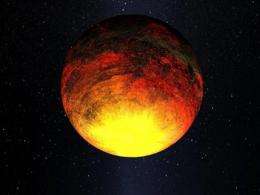NASA spots 54 potentially life-friendly planets

An orbiting NASA telescope is finding whole new worlds of possibilities in the search for alien life, including more than 50 potential planets that appear to be in the habitable zone.
In just a year of peering out at a small slice of the galaxy, the Kepler telescope has spotted 1,235 possible planets outside our solar system. Amazingly, 54 of them are seemingly in the zone that could be hospitable to life - that is, not too hot or too cold, Kepler chief scientist William Borucki said.
Until now, only two planets outside our solar system were even thought to be in the "Goldilocks zone." And both those discoveries are highly disputed.
Fifty-four possibilities is "an enormous amount, an inconceivable amount," Borucki said. "It's amazing to see this huge number because up to now, we've had zero."
The more than 1,200 newfound bodies are not confirmed as planets yet, but Borucki estimates 80 percent of them will eventually be verified. At least one other astronomer believes Kepler could be 90 percent accurate.
After that, it's another big step in proving that a confirmed planet has some of the basic conditions needed to support life, such as the proper size, composition, temperature and distance from its star. More advanced aspects of habitability such as specific atmospheric conditions and the presence of water and carbon require telescopes that aren't built yet.
Just because a planet is in the habitable zone doesn't mean it has life. Mars is a good example of that. And when scientists look for life, it's not necessarily intelligent life; it could be bacteria or mold or a form people can't even imagine.
Before Wednesday, and the announcement of Kepler's findings, the count of planets outside the solar system stood at 519. That means Kepler could triple the number of known planets.
Kepler also found that there are many more relatively small planets, and more stars with more than one planet circling them - all hopeful signs in the search for life.
"We're seeing a lot of planets and that bodes well. We're seeing a lot of diversity," said Kepler co-investigator Jack Lissauer, an astronomer at the University of California Santa Cruz.
All the stars Kepler looks at are in our Milky Way galaxy, but they are so far away that traveling there is not a realistic option. In some cases it would take many millions of years with current technology.
What gets astronomers excited is that the more planets there are - especially those in the habitable zone - the greater the odds that life exists elsewhere in the universe.
Yale University astronomer Debra Fischer, who wasn't part of the Kepler team but serves as an outside expert for NASA, said the new information "gives us a much firmer footing" to hope for worlds that could harbor life. "I feel different today, knowing these new Kepler results, than I did a week ago," Fischer said.
Another outside astronomer, Lisa Kaltenegger of Harvard University, called the findings "exciting good news."
Kaltenegger said to be in the habitable zone, a planet has to be the proper distance from its star so that it could have liquid water on its surface, or ground temperatures roughly averaging between 32 degrees and 212 degrees Fahrenheit. That distance varies by star; weaker stars, for example, would require planets to be closer to be habitable.
Because of the various factors that could make planets more prone to life, University of California Santa Cruz astronomer Greg Laughlin created a formula that puts a dollar value on these far-off planets with the idea that the first planet that is incredibly similar to Earth would have a value of $1 million.
Until Wednesday, the highest value Laughlin assigned to an exoplanet, which is what astronomers call a planet outside our solar system, was a measly $158. One of Kepler's new discoveries is worth nearly a quarter-million dollars, Laughlin figures.
Kepler was launched in 2009 and orbits the sun between Earth and Mars. It needs time to find planets. It identifies them by watching them repeatedly move past the star they orbit.
Kepler scientists are strict about calling candidate planets confirmed. Of 400 candidate planets announced last year, only nine of Kepler's discoveries had been confirmed before Wednesday.
Of the more than 800 new candidates, both in and out of the habitable zone, only six are confirmed, all way too hot for life. And they are strange - all densely packed and circling a single star. Five of them are closer to their star than Mercury is to our sun, and they move in precise circular and stable orbits.
Two are only twice as wide as Earth - which in the world of exoplanets is practically Earth-like - and the others are closer in size to Neptune or Uranus, which are three to four times the size of Earth.
Kepler astronomers revealed the strange star system in a study published Wednesday in the journal Nature. NASA announced other elements of Kepler's findings.
In addition to the pure numbers of planet candidates and their locations, their relative size also encourages astronomers. Kepler has found there are more planets considerably smaller than Jupiter - the biggest planet in our solar system - than there are giant planets.
Size matters when it comes to planets and their potential for life. Very large planets are unlikely to be solid; they are more prone to be gas behemoths like Jupiter. Astronomers think a planet needs to be solid - rocky like Earth or Mars - for life to develop.
More information:
NASA's Kepler mission: http://www.nasa.gov/mission-pages/kepler/main/index.html
Nature: http://www.nature.com/nature
©2010 The Associated Press. All rights reserved. This material may not be published, broadcast, rewritten or redistributed.




















